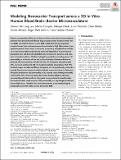| dc.contributor.author | Lee, Sharon Wei Ling | |
| dc.contributor.author | Campisi, Marco | |
| dc.contributor.author | Osaki, Tatsuya | |
| dc.contributor.author | Possenti, Luca | |
| dc.contributor.author | Mattu, Clara | |
| dc.contributor.author | Adriani, Giulia | |
| dc.contributor.author | Kamm, Roger Dale | |
| dc.contributor.author | Chiono, Valeria | |
| dc.date.accessioned | 2021-10-27T20:23:51Z | |
| dc.date.available | 2021-10-27T20:23:51Z | |
| dc.date.issued | 2020 | |
| dc.identifier.uri | https://hdl.handle.net/1721.1/135529 | |
| dc.description.abstract | © 2020 WILEY-VCH Verlag GmbH & Co. KGaA, Weinheim Polymer nanoparticles (NPs), due to their small size and surface functionalization potential have demonstrated effective drug transport across the blood–brain–barrier (BBB). Currently, the lack of in vitro BBB models that closely recapitulate complex human brain microenvironments contributes to high failure rates of neuropharmaceutical clinical trials. In this work, a previously established microfluidic 3D in vitro human BBB model, formed by the self-assembly of human-induced pluripotent stem cell-derived endothelial cells, primary brain pericytes, and astrocytes in triculture within a 3D fibrin hydrogel is exploited to quantify polymer NP permeability, as a function of size and surface chemistry. Microvasculature are perfused with commercially available 100–400 nm fluorescent polystyrene (PS) NPs, and newly synthesized 100 nm rhodamine-labeled polyurethane (PU) NPs. Confocal images are taken at different timepoints and computationally analyzed to quantify fluorescence intensity inside/outside the microvasculature, to determine NP spatial distribution and permeability in 3D. Results show similar permeability of PS and PU NPs, which increases after surface-functionalization with brain-associated ligand holo-transferrin. Compared to conventional transwell models, the method enables rapid analysis of NP permeability in a physiologically relevant human BBB set-up. Therefore, this work demonstrates a new methodology to preclinically assess NP ability to cross the human BBB. | |
| dc.language.iso | en | |
| dc.publisher | Wiley | |
| dc.relation.isversionof | 10.1002/ADHM.201901486 | |
| dc.rights | Creative Commons Attribution-NonCommercial-NoDerivs License | |
| dc.rights.uri | http://creativecommons.org/licenses/by-nc-nd/4.0/ | |
| dc.source | Wiley | |
| dc.title | Modeling Nanocarrier Transport across a 3D In Vitro Human Blood‐Brain–Barrier Microvasculature | |
| dc.type | Article | |
| dc.contributor.department | Singapore-MIT Alliance in Research and Technology (SMART) | |
| dc.contributor.department | Massachusetts Institute of Technology. Department of Mechanical Engineering | |
| dc.contributor.department | Massachusetts Institute of Technology. Department of Biological Engineering | |
| dc.relation.journal | Advanced Healthcare Materials | |
| dc.eprint.version | Final published version | |
| dc.type.uri | http://purl.org/eprint/type/JournalArticle | |
| eprint.status | http://purl.org/eprint/status/PeerReviewed | |
| dc.date.updated | 2020-08-17T16:45:07Z | |
| dspace.orderedauthors | Lee, SWL; Campisi, M; Osaki, T; Possenti, L; Mattu, C; Adriani, G; Kamm, RD; Chiono, V | |
| dspace.date.submission | 2020-08-17T16:45:10Z | |
| mit.journal.volume | 9 | |
| mit.journal.issue | 7 | |
| mit.license | PUBLISHER_CC | |
| mit.metadata.status | Authority Work and Publication Information Needed | |
